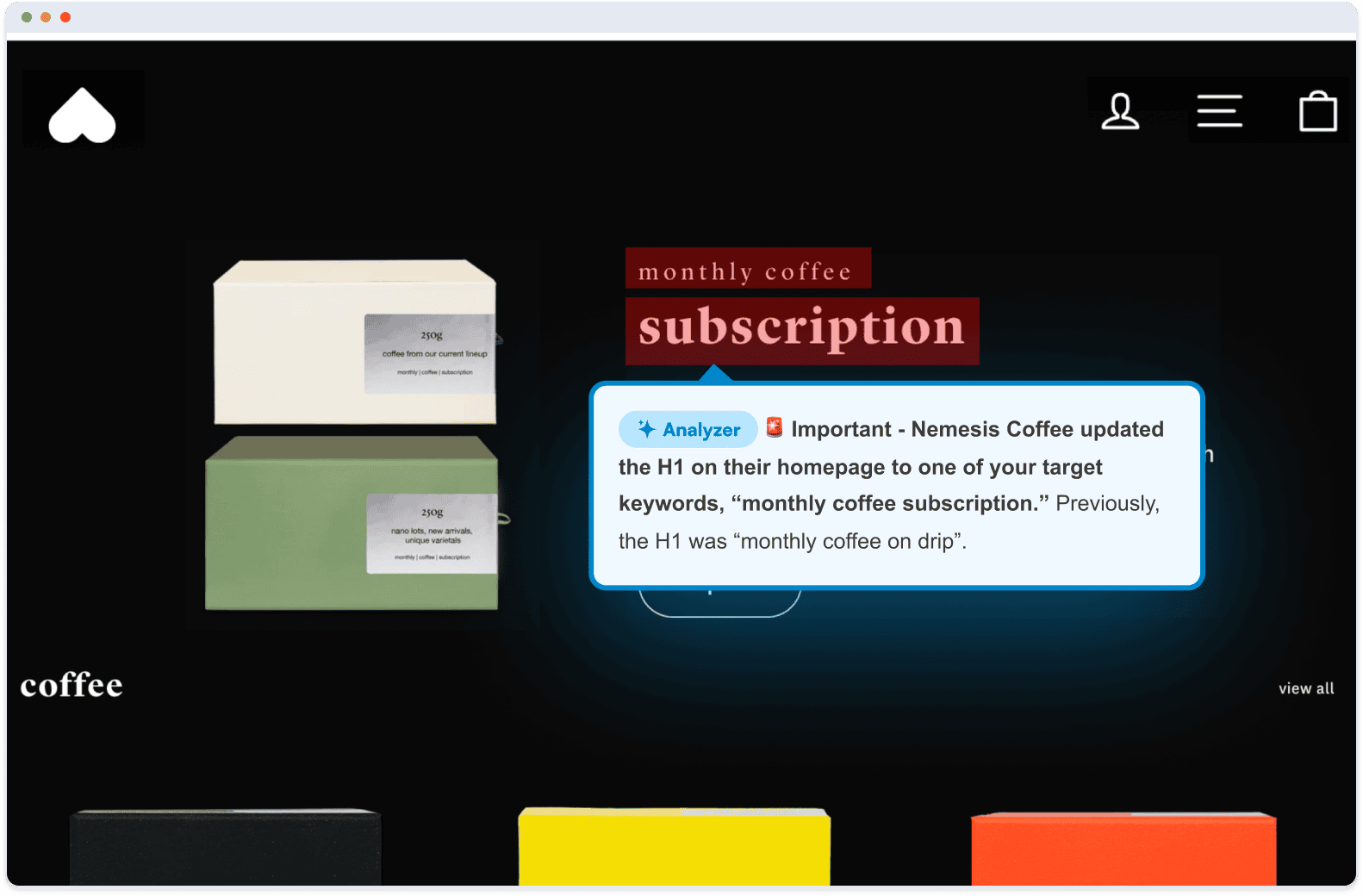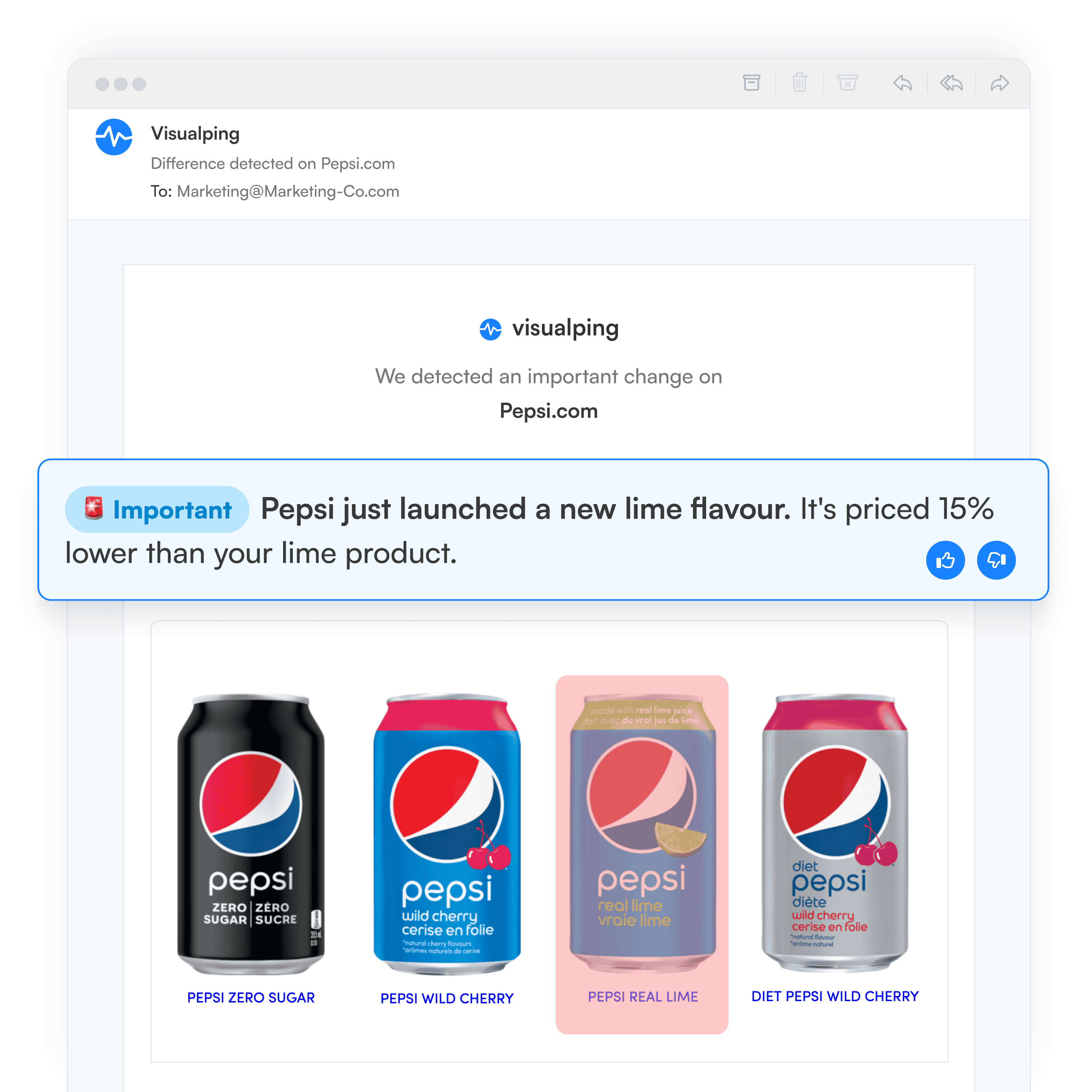Top Competitor Website Analysis Tools in 2025
By Emily Fenton
Updated August 22, 2025

Introduction
Staying competitive in today’s market means understanding what your competitors are up to.
Thankfully nowadays, there are a wide array of tools to keep an eye on your rivals. Automated competitor tools make it easier to drill down on the websites of your competition, which can uncover valuable insights regarding pricing, products, upcoming launches and shifts in marketing strategies.
Companies can also gain insights about the performance, audience engagement, and search engine optimization of their competitors’ websites.
This type of intel can inform your own business decisions, helping you understand what customers want and how the market is changing.
But with all the different competitor analysis tools out there in the market today, it can be a bit overwhelming figure out which one works best for your business.
Companies should opt for tools that match their specific competitive intelligence goals and needs instead of choosing the fanciest option. These competitor analysis tools also specialize in different features, and so it’s important to evaluate the tools based on your team’s goals.
In this article, we’ll dig into what businesses can learn from analyzing their competitors’ websites, and take a look at the top competitor website analysis tools to help your business stay ahead of the curve.
Why You Should Analyze Competitor Websites

Monitoring competitor websites provides critical insights that shape successful business strategies. But, one of the first things you need to know is that there are many different ways you can track a website.
Depending on your goals, there are all kinds of competitor tools that can help you analyze the information you want to know. We’ll get into that in a bit.
A competitor's websites reveals multiple layers of data, from content updates in their blog page, to new design refreshes, to keyword optimizations and technical improvements.
Or, maybe you want to drill down into more technical data, like the software technology their website is using, or your competitors’ backlink profile or traffic.
Let’s go over some of the ways you can monitor and analyze competitor websites for competitive intelligence.
Home Page Updates Are a Big Deal
When competitors revamp their home page, these changes usually represent some significant strategic decisions.
Monitor your competitor’s home page for updates like:
- Primary messaging and value propositions
- Visual branding updates
- Product positioning changes
- Customer testimonial additons or removals
These modifications often reflect broader marketing strategy adjustments, like shifting their target audience, introducing new products, or responding to market pressures, so definitely keep an eye for any changes to their home page.
Pricing Changes Can Help You Stay Competitive
Monitoring competitor pricing gives businesses a strategic advantage in the marketplace. Changes in pricing often indicate broader shifts in strategy, market positioning, or reactions to economic pressures.
In sales, the pricing page is often one of the most carefully crafted pages on a website, updated only when something significant changes. By keeping track of your competitors’ pricing pages, you can stay informed about important adjustments to their pricing strategies.
These pages are typically packed with information, and manually checking them for any updates can be incredibly time-consuming and inefficient.
An AI website monitoring tool like Visualping can be super handy for automatically monitoring competitor pages for you. Visualping will notify you of any changes so you can save time, while staying in the know.
Yehor Melnykov, CEO and Co-founder of Loio, an AI-driven legal software company, says that AI-driven competitive intelligence tools have made significant changes.
"AI has made competitive intelligence less about gathering and more about synthesizing," he said. "Before, teams spent endless hours collecting raw data. Now, AI handles the collection and surfaces the 'why it matters.'"
He says this shift towards using AI for competitive intelligence efforts helps free up important time for interpretation and decision-making rather than "drowning in spreadsheets."

Navigation Menu Changes Tell You Where they Want Traffic
Updates to a company's navigation signals where they are trying to direct attention to on the website.
These structural modifications to their site often correlate with broader digital marketing initiatives. Businesses may adjust navigation to support PPC campaigns, improve conversion rates, or align with SEO goals.
Try using Visualping’s advanced features to reveal updates to navigation elements and monitor only the specific dropdowns you care about.
Executive Team Page Reveal Strategic Moves
Most companies showcase their leadership team online on their team or executive page. Changes to these pages, such as a key departure or new hire, can signal where competitors are reallocating resources (e.g a new Director of Marketing hire signals increased marketing focus), making strategic investments, or strengthening areas of focus.
Monitoring these updates provides insight into where they see opportunities or have already begun significant initiatives.
Press Release Pages Tell You Where They’re Trying to Stand Out
Press release pages are a no-brainer to monitor. Corporate updates from a press release page can keep you up-to-date on the latest awards, partnerships, product releases, and corporate development activities. You can see the bets your competitor is making, and where they’re trying to stand out.
Importance of Using Automated Website Analysis Tools
Traditional approaches to competitor analysis, which involve manually rechecking competitor websites and recording your observations, are time-consuming and inefficient. There’s also plenty of room for human error, and accidentally missing an important update.
Competitor monitoring and analysis is no longer a nice-to-have but a necessity for businesses to thrive. In order to do so efficiently, automated tools have become the industry norm.
Alex Vasylenko, Founder of Digital Business Card advises business owners to "start small" with using competitive intelligence tools.
"Don't rush into complex competitive intelligence tools right away, start small and become smart," he said. "Start with data from inside the company and insights from customers to develop a strong base.”
Here’s our list of the top competitor website analysis tools to use in 2025.
Top Competitor Website Analysis Tools
Visualping
Getting inspired by UX and visual changes on competitors’ websites

Visualping is a powerful AI solution for staying on top of your competition’s websites.
The competitor monitoring tool automatically checks web pages for changes. When Visualping detects a change, it sends you an email alert, with an AI-generated summary of the change, distilled in two to three lines. It also includes a screenshot of the change, the changes highlighted, so it's easy to understand the update.

By staying aware of the latest updates on your competitors’ websites, Visualping sets you up for being able to analyze the exact, specific competitor information your team wants to focus on.
Because of the screenshot feature, Visualping is an excellent option for getting inspired by UX and CRO tweaks on competitors’ websites.
You can observe how your competitors are trying to squeeze more out of every visitor to their website. In other words, you can look for user experience (UX) and conversion rate optimization (CRO) tweaks that you can adopt without having to do all the research and A/B testing.
But, the screenshots aside, the email alerts also include an AI-generated summary of the changes, making it easier for you to understand the update more quickly and easier.
Pricing
Visualping offers several flexible subscription options, starting at $25/month, which lets you monitor up to 100 pages, with a max frequency of every 15 minutes (5,000 available checks/month).
Ahrefs
Drilling Down on Website SEO Data to Improve Your Site’s Search Performance
Ahrefs is a strong SEO toolset with up-to-date data on the search performance of competitors’ websites. But as well as getting a breakdown of how your competitors are doing in the search, you can drill down on the website data behind their performance – like how many backlinks their web domain has, the keywords they do and don’t rank for, and more.
You can see where your competitors get their backlinks from, so you can replicate their tactics or go after their links. You can see how well your organic search is, relative to competitors, and even find content gaps between you and your competitors.
My favorite functionality: Finding content gaps between you and your competitors This feature shows keywords for which your competitors rank but you don’t. These are called content gaps and can give you proven content ideas for your content planning.
Pricing
Drilling into website SEO data isn’t cheap. Ahrefs’ cheapest subscription starts at $99/month.
BuiltWith
Checking any Websites’ Tech Stacks
BuiltWith is a competitor analysis tool that helps you identify the technologies any website is using, like advertising platforms, payment systems, web servers, and CDNs. You can use it to identify the niche advertising platforms your competitors use, and see if you can advertise there too.
Pricing
Plans with BuiltWith start at $295/month.
Similarweb
Getting a Good Look at Your Competitors’ Traffic
Similarweb is a competitor website analysis software that makes researching your competition’s website traffic super easy and fast. It shows you what’s happening right now by revealing the most up-to-date traffic data, detailed visitor behavior, plus paid advertising, affiliate, social, and SEO content strategies.
For this reason, it’s a great solution for getting a birds’ eye view of the industry landscape.
You can also dig deeper into your competitor’s audience by accessing geographic and demographic data to understand how and where to meet your audience. You can even see the marketing channels delivering the most traffic within your industry.
Pricing
The most basic starter plan is $125/month. The other option for individuals and startups is $333/month.
BuzzSumo
Best Uncovering Content Opportunities to Improve Your Organic Search
A great way to analyze your competitors’ websites is to see which of their web content is performing well, and you can do this with BuzzSumo. It’s a website content analysis tool that lets you see which content has the best engagement, and outreach gaps across search.
You can look at high-performing posts, niche keywords, trending stories, and customer questions to learn what content resonates with your target audience. Use those insights to elevate your own storytelling on your website content to improve your search performance.
Pricing
The most basic plan is for marketers, with a focus on content creation, starting at $199/month.
Feedly
Getting Content Ideas from Competitor Blog Content
You may be interested in your competitors’ blog for various reasons – content inspiration, insights about what your audience is interested in, indications of their future plans and shifts in their branding and marketing messages for competitive intelligence.
If you’re looking for a way to keep an eye on a competitor’s content without manually checking up on it, Feedly is a simple, but convenient, way to do that.
It’s a content aggregator that stores and organizes content as it’s published, including that of your competitors. This allows you to see hot topics covered by the competition, all on one page.
Pricing
Besides the free option, you can start getting some premium features for just $6/month.
The Final Verdict
Competitor website analysis tools give businesses a clear window into what’s happening in their market, and are a must-have for any business looking to set themselves apart in their market.
Competitor sites are full of valuable information, from pricing and product offerings to marketing strategies and upcoming launches.
Before investing in a tool, it’s important to define your team’s goals. Different tools highlight different types of insights, so knowing what you want to track, whether it’s pricing changes, content updates, or new product releases, will help you choose the right solution and get the most actionable information.
Frequently Asked Questions
Why should I analyze my competitors' websites?
Analyzing competitor websites provides valuable intelligence on their pricing, product launches, and marketing strategies. These insights helps you understand market changes and customer preferences, allowing you to make more informed business decisions and stay competitive.
What key areas of a competitor's website are most important to monitor?
There are several key areas to monitor to gain the most strategic insights:
- Home Page: For changes in messaging, branding, and product positioning.
- Pricing Pages: To detect strategic adjustments and stay competitive.
- Navigation Menus: To see where they are trying to direct user traffic.
- Executive Team and Press Release Pages: For clues about new hires, partnerships, and strategic investments.
How do I choose the right competitor analysis tool for my business?
First, define your team’s specific competitive intelligence goals. Different tools specialize in different types of data. For example, some focus on SEO data (Ahrefs), others on website traffic (Similarweb), and some on tracking visual page changes like pricing updates (Visualping). The best approach is to choose the tool that directly aligns with the specific information you need to gather.
Want to monitor web changes that impact your business?
Sign up with Visualping to get alerted of important updates, from anywhere online.
Emily Fenton
Emily is the Product Marketing Manager at Visualping. She has a degree in English Literature and a Masters in Management. When she’s not researching and writing about all things Visualping, she loves exploring new restaurants, playing guitar and petting her cats.